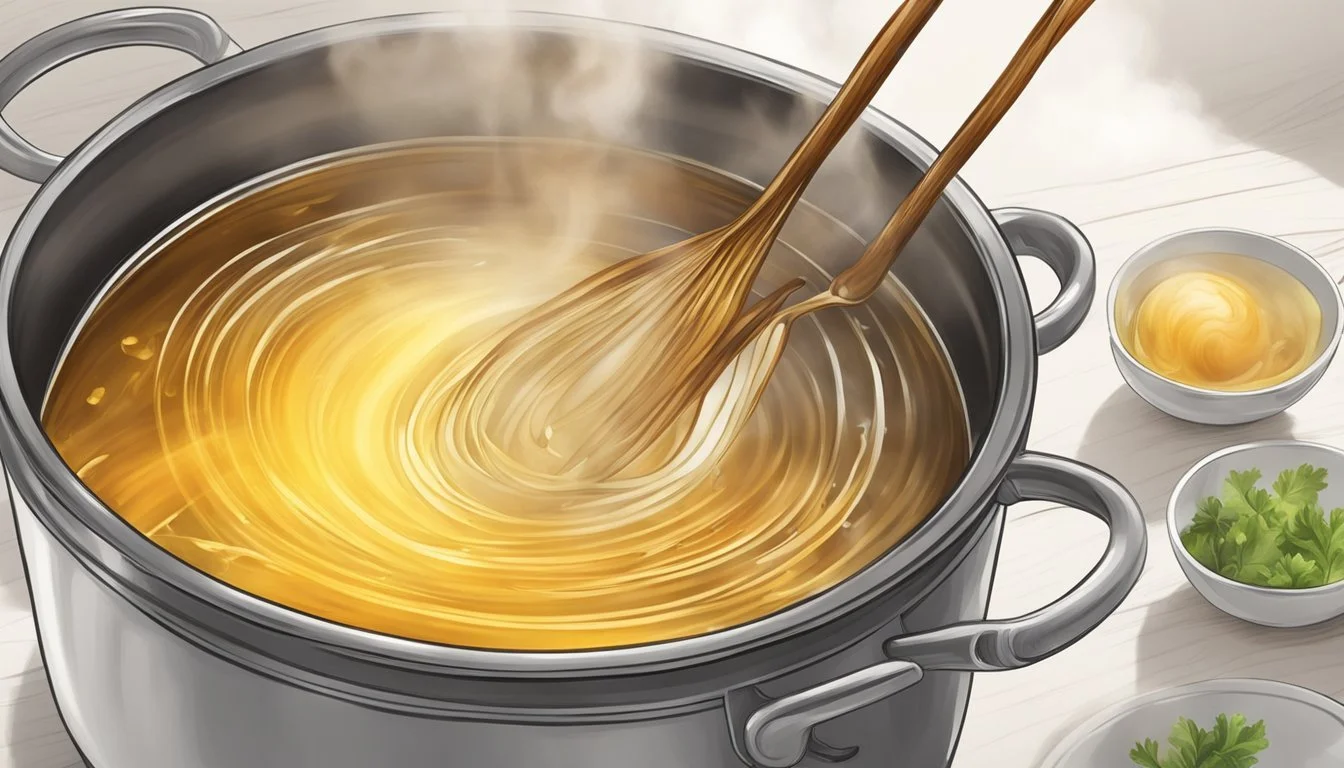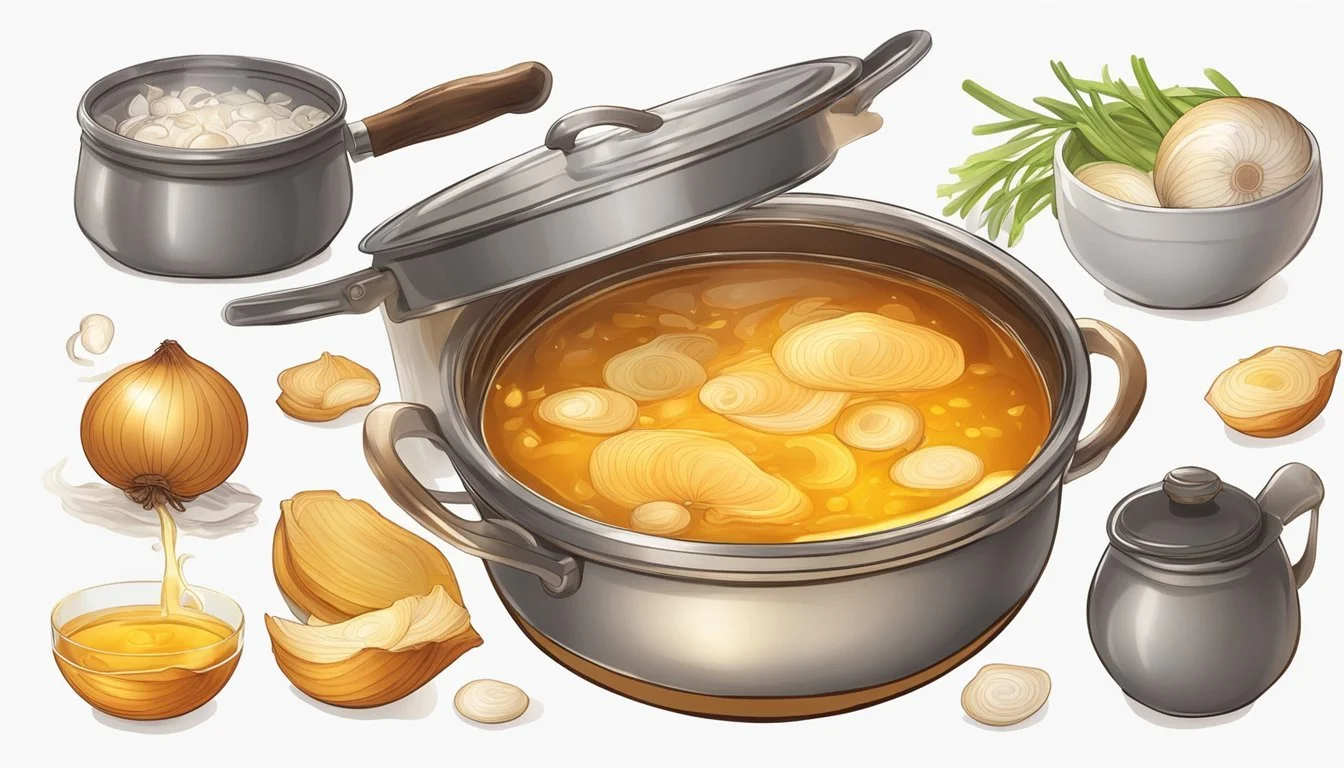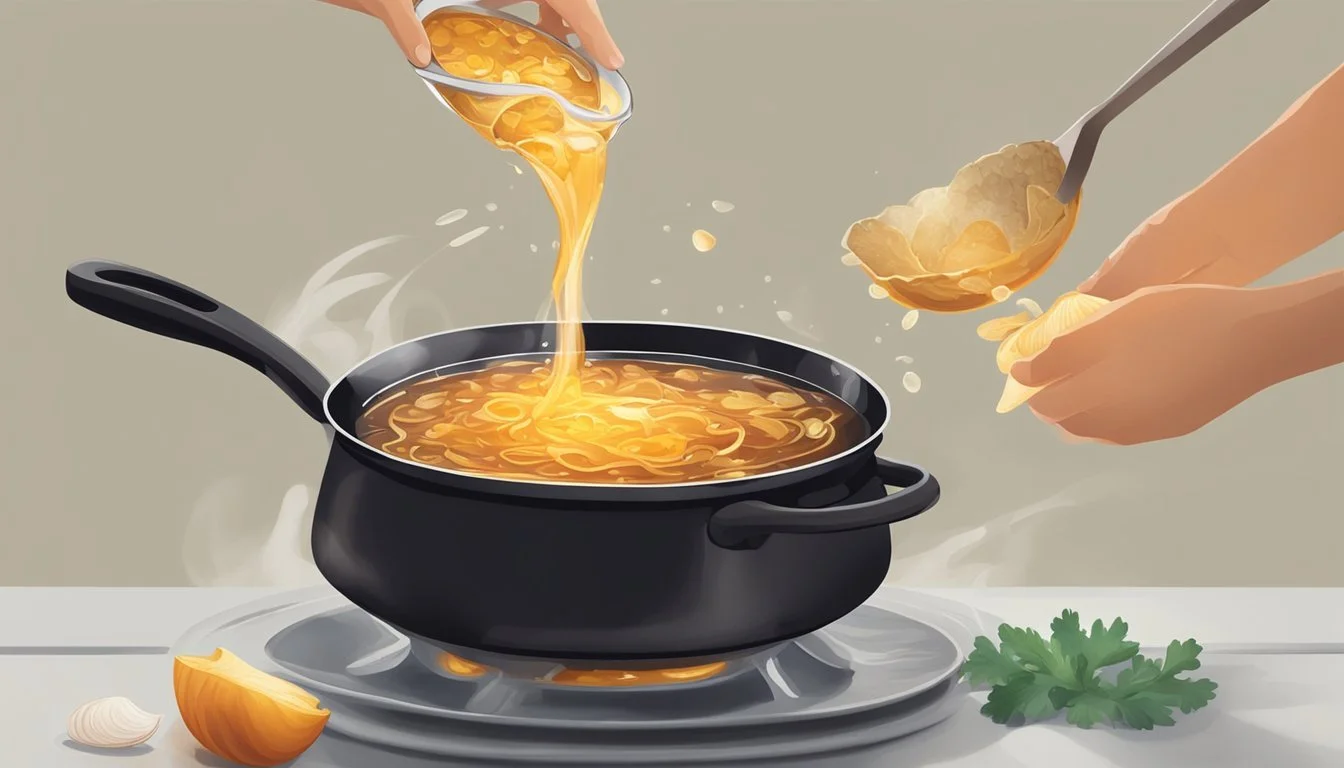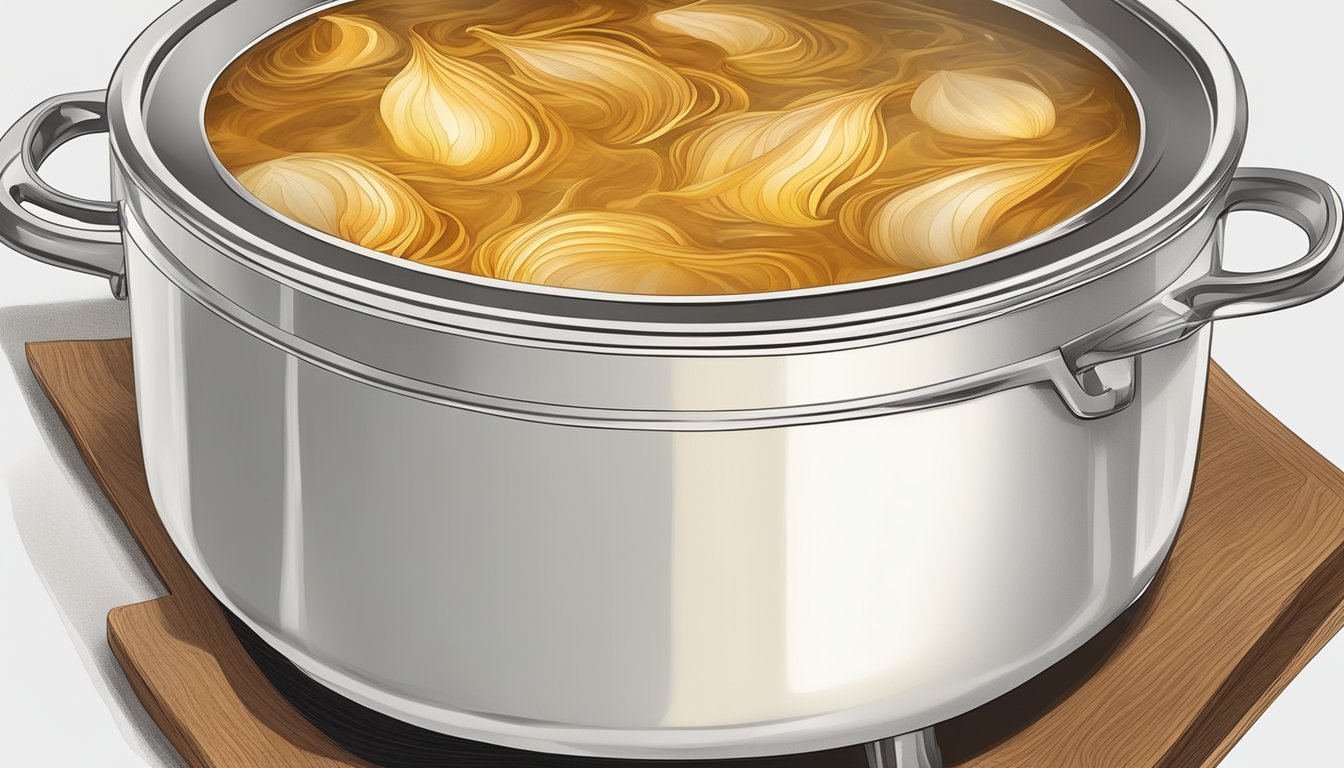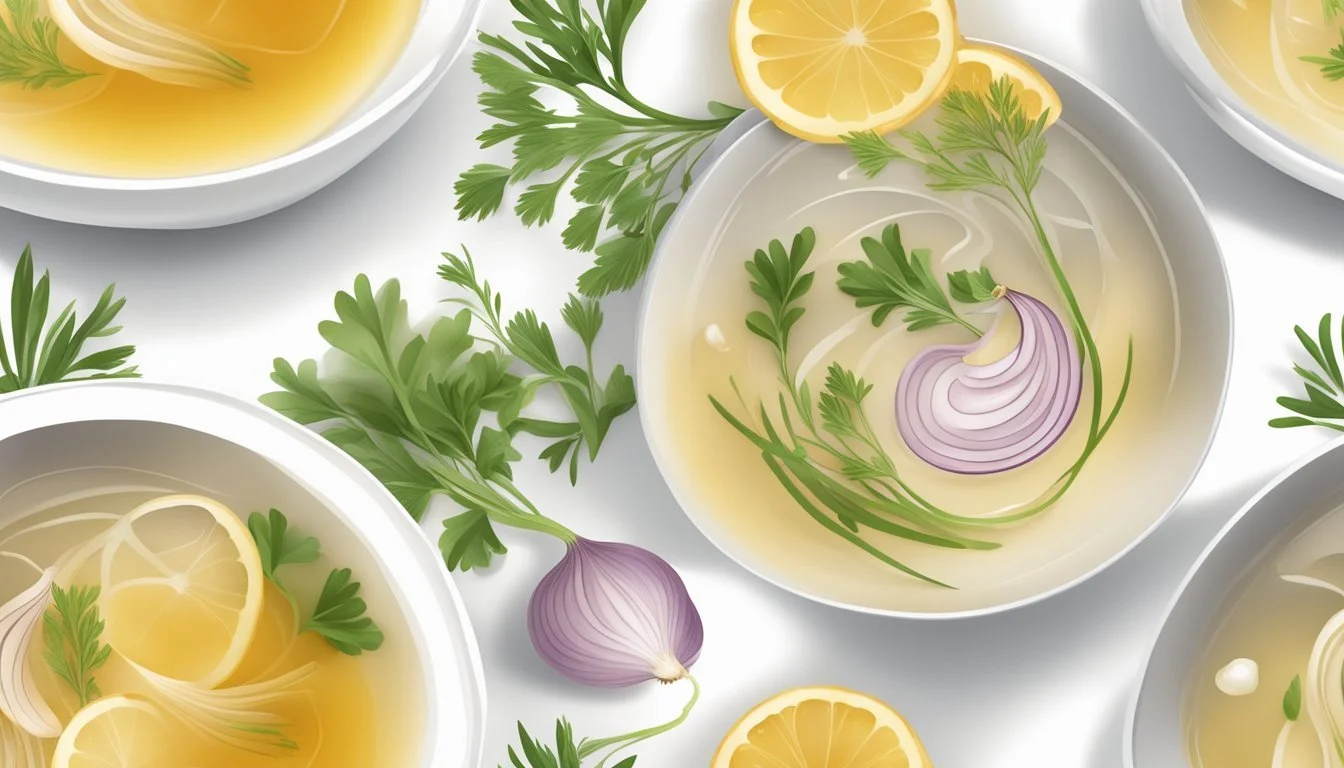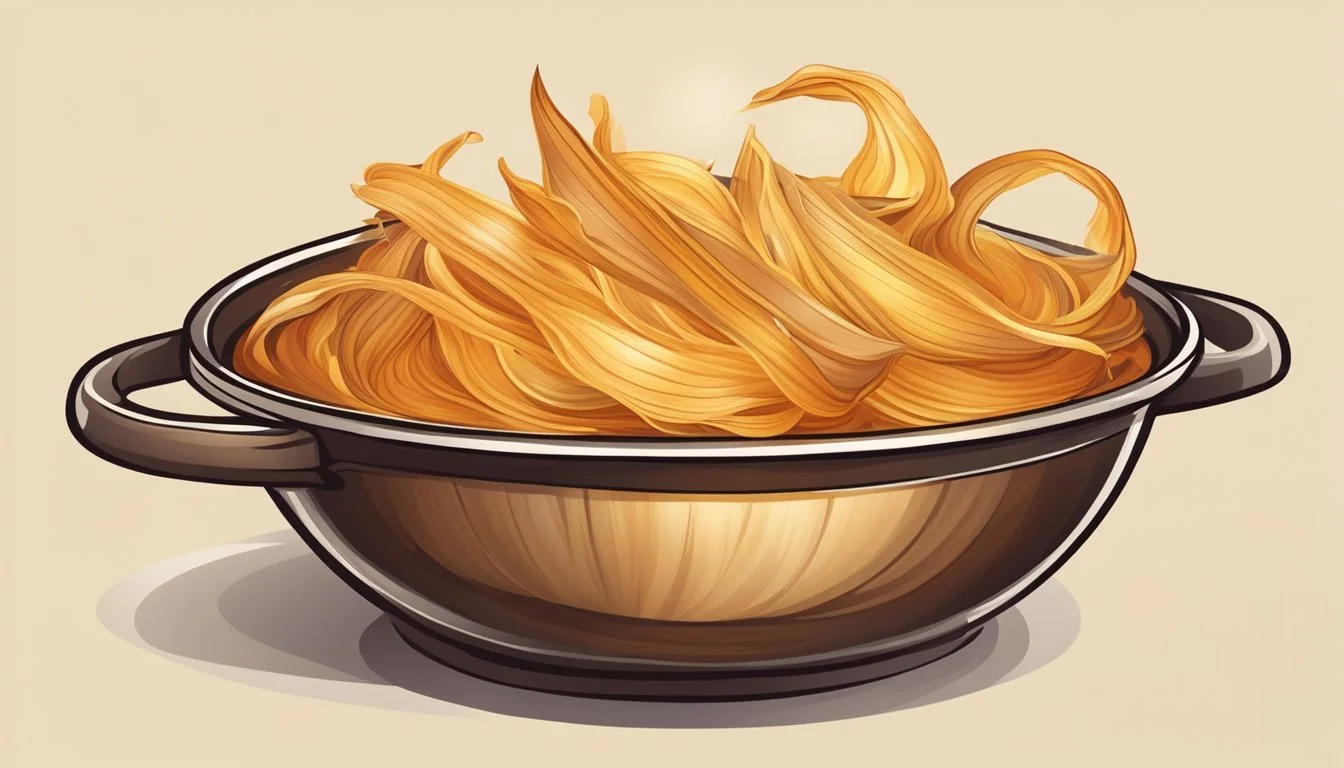Onion Skin Broth
A Flavorful, Amber-Hued Base for Nutritious Soups
Onion skin broth emerges as an underappreciated hero in the culinary world, offering a rich, amber-colored liquid that's both sustainable and flavorful. This broth is made by simmering the outer skins and ends of onions, (What wine goes well with onions?) which are often discarded, with other aromatic components. The resulting infusion boasts a depth of flavor that enhances a myriad of dishes, from soups and stews to risottos and sauces. It captivates not just with its taste but also with its visually appealing golden hue, reminiscent of amber.
The beauty of onion skin broth lies in its simplicity and the almost alchemic transformation of scraps into a treasure of the kitchen. It embodies a zero-waste philosophy, encouraging cooks to utilize every part of an ingredient. Beyond its taste and environmental benefits, onion skins are a source of plant compounds such as flavonoids, including quercetin, which have been recognized for their antioxidant and anti-inflammatory properties.
Creating this broth doesn't require expert skills or exotic ingredients. Water, onion skins, and a few selected additions like garlic, bay leaves, and peppercorns are the basic elements needed to craft this aromatic base. Salt can be added to taste, ensuring the broth’s versatility in a wide array of recipes. Thus, onion skin broth stands as a testament to the fact that remarkable flavors can be discovered in the most unassuming places.
History and Origin of Onion Skin Broth
Onion skin broth reflects centuries of culinary tradition, transforming a simple ingredient's outer layer into a base with depth and health benefits.
Regional Variations
The use of onion skins in broth varies by region, with some cultures incorporating them for their color and flavor. In Jewish cuisine, for instance, onion skins are a traditional component in chicken broth, prized for imparting an amber hue and enhancing the overall taste. Across various cultures, onion skins in broth have served not just a culinary purpose but also emerged as a means to reduce waste and utilize all parts of the vegetable.
Italian Influence
Italian cooking has long valued the concept of "cucina povera," or "poor kitchen," which emphasizes making the most out of simple, available ingredients. In this respect, onion skin broth aligns well with Italian culinary practices. It utilizes an often-discarded element, the peels, to create a flavorful broth. This practice is especially pertinent given Italy's historical periods of austerity, where frugality was necessary, and nothing edible went to waste. The broth captures the essence of the onion's outer layers, rich in antioxidants, notably quercetin.
Ingredients and Preparation
The savory journey of crafting Onion Skin Broth begins with sourcing quality onions and skillfully coaxing out their richest flavors to create an amber-hued base that is not only aromatic but also robust in taste.
Selecting the Right Onions
For a broth rich in color and flavor, one should select yellow onions. The skins of yellow onions contribute a deeper amber color to the broth. It's recommended to accumulate skins and ends from approximately three yellow onions. Additionally, one might consider the inclusion of garlic bulb skins to add complexity to the flavor profile.
Extracting Maximum Flavor
To unlock the full potential of the onions' flavors, the following ingredients should be simmered together:
Onion skins and ends
Garlic bulb skins
3 dried bay leaves
2 dried mushrooms, broken into pieces
1 tsp sugar (optional)
1 tsp black peppercorns
One should add approximately 65 oz of water, ensuring it remains 1 inch below the maximum fill level of the pot to avoid overspilling. The mixture needs to be simmered until the desired intensity of flavor is achieved. Salt can be adjusted to taste after the broth is strained, discarding the solids. This process results in a broth that encapsulates the essence of onions, a base teeming with the warmth of their amber palette and the depth of their earthy flavor.
The Color of Onion Skin Broth
The unique coloration of onion skin broth is attributed to natural pigments that are released during the cooking process, offering an appealing amber hue that is not just visually striking but also indicative of the broth's flavor profile.
Natural Pigments and Hues
Onion skins contain a variety of natural pigments, with quercetin being one of the most prominent. Quercetin is a flavonoid that imparts a range of colors to foods, from yellow to brown. The concentration and condition of these pigments as the broth simmers play a critical role in the resulting color of the broth. As the onion skins steep and simmer in hot water, they gradually release their pigments, which mingle with the broth, transforming it from a clear liquid to a more vibrant, colorful concoction.
Achieving the Amber Hue
To achieve the characteristic amber hue of onion skin broth, one must consider both the type of onions used and the length of the cooking process:
Type of Onions: Yellow onions are often recommended for their strong balance of astringency and sweetness, and their skins are known for producing a rich amber color.
Cooking Time: The longer the skins are allowed to simmer in the broth, the more pronounced the amber color will become. However, a delicate balance should be maintained to prevent bitterness from overtaking the broth's flavor.
The color of the broth is not merely cosmetic; it can signify the depth of flavor that the broth possesses. A deeper amber hue often suggests a robust, well-rounded flavor profile that is both earthy and slightly sweet, adding a complex base to a variety of dishes.
Culinary Uses
Onion skin broth offers a unique amber hue and a depth of flavor to a variety of dishes, invigorating recipes with its rich, savory notes.
As a Base for Dishes
Onion skin broth serves as an exceptional foundation for countless recipes. Its robust flavor enhances the taste profiles of soups and gravies, transforming them from simple to spectacular. Chefs often incorporate it into the cooking liquid for grains such as rice, where it imparts its signature amber tint and subtle taste nuances.
Soups and Stews: The broth adds complexity and a warm color.
Grains: Rice or couscous (What wine goes well with couscous?) cooked in the broth acquire a beautiful hue and extra flavor.
Pairing with Proteins
When it comes to proteins, onion skin broth pairs remarkably well, particularly with grilled meats. (What wine goes well with grilled meats?) The broth's hearty nature complements the smoky flavors of grilled meat beautifully, either as a marinating base or as a braising liquid to ensure the meat stays moist and flavorful.
Grilled Meats: A splash of broth can be used in a marinade to tenderize and flavor the meat before it hits the grill.
Braises: Slow cooking tougher cuts of meat in onion skin broth imparts flavor and tenderness.
Serving and Presentation
The clear, amber hue of onion skin broth brings a warm aesthetic to the table, making the choice of serving container and garnishing crucial for an impressive presentation.
Choosing the Right Container
Selecting the right bowl or dish is key to enhancing the visual appeal of onion skin broth. A clear glass bowl or an earth-toned ceramic dish can complement the broth's amber color. The rim of the serving container should be wide enough to allow for easy sipping while also leaving space for garnishes that elevate the dish’s presentation.
Garnishing and Final Touches
A thoughtful garnish can transform onion skin broth from a simple dish to an elegant offering. Consider the following garnishing tips:
Chopped Herbs: A sprinkle of freshly chopped parsley or chives adds vibrant color contrast and fresh flavor.
Edible Flowers: A single edible flower placed delicately on the surface serves as a focal point and accentuates the broth's golden tones.
Crusty Bread: A side of crusty, artisan bread can provide a textural balance and a means to soak up the flavorful broth.
Through the combination of precise container choice and tasteful garnishing, onion skin broth is visually elevated, creating a dining experience that delights both the palate and the eyes.
Craft and Artistry in Broth Making
Creating onion skin broth is both a craft and an art, requiring skill in developing flavors and a keen sense for aesthetics in presentation.
The Craft of Broth Making
The craft of broth making is rooted in the methodical selection and preparation of ingredients. For onion skin broth, the primary item of focus is the onion skin, typically discarded but rich in flavor and color. The process begins with gathering these skins, ensuring they are clean and free of spoilage.
Ingredients:
Onion skins and trimmings
Water
Optional: Other vegetable trimmings, herbs, and spices
Steps:
Collect a sufficient quantity of onion skins.
Place the onion skins into a pot and cover with water.
(Optional) Add additional vegetable trimmings, herbs, or spices for complexity.
Slowly bring to a simmer, allowing the flavors to infuse the water for a rich broth.
Strain the broth to remove the solids, resulting in a clear amber-hued liquid that serves as an excellent base for further culinary applications.
The craft centers around extracting the maximum amount of essence from an often-overlooked item to produce a broth that is both nutritious and cost-effective.
The Artistry of Presentation
How a broth is presented can elevate the simplest dishes to appear as culinary works of art. The onion skin broth, with its distinct amber hue, naturally possesses aesthetic appeal, which can be enhanced through thoughtful presentation.
Presentation Tips:
Serve in a clear bowl or cup to showcase the broth's color.
Garnish with a sprig of fresh herb, such as parsley or thyme, for contrast.
Float a few caramelized onion pieces on top as a nod to the broth's origin.
The artistry of presentation relies on the understanding that we eat with our eyes first, and a visually appealing dish sets expectations for the culinary experience to follow. The onion skin broth, despite its simple origins, can become a showcase of skill when its presentation is given the same attention as its preparation.

